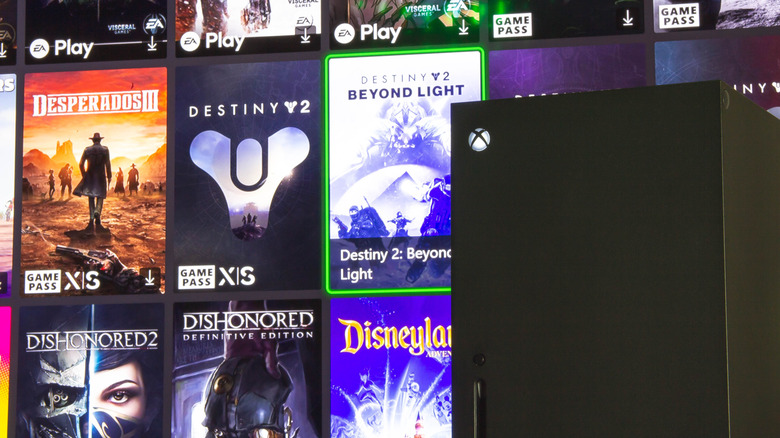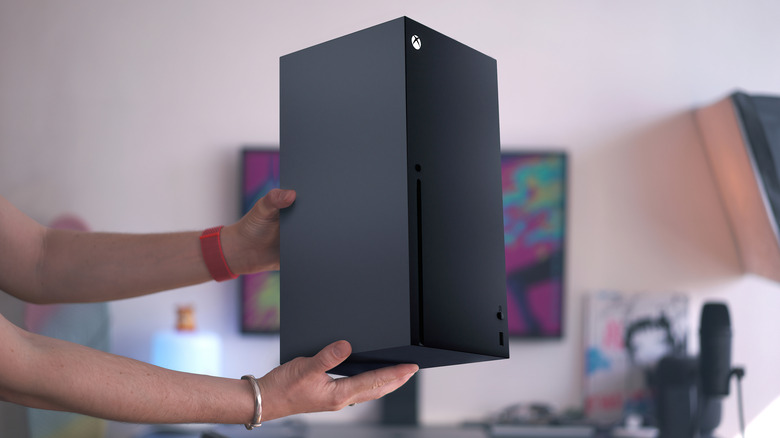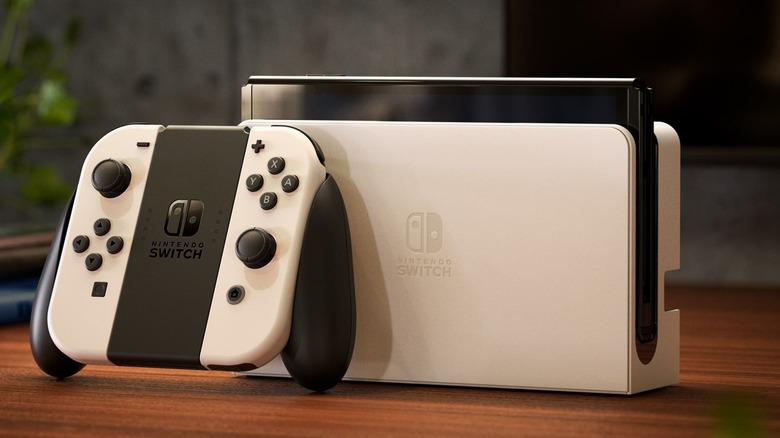

Microsoft Is Hiking The Price Of Its Xbox Games To $70
source link: https://www.slashgear.com/1127333/microsoft-is-hiking-the-price-of-its-xbox-games-to-70/
Go to the source link to view the article. You can view the picture content, updated content and better typesetting reading experience. If the link is broken, please click the button below to view the snapshot at that time.
Microsoft Is Hiking The Price Of Its Xbox Games To $70

Microsoft had been a notable holdout among game developers in their quest to creep prices higher. The trend started at the onset of this console generation, when publishers like EA and Ubisoft began selling their newest games for $70 each in the fall. The standard price for new AAA titles had hovered around $60 before.
Now, Microsoft is finally joining its contemporaries in raising prices. Speaking with Eurogamer, the company confirmed it will be upping the cost of its newest full-priced titles in 2023 to $70. You can expect the latest "Forza Motorsport," "Redfall," and Bethesda's "Starfield" to be the first examples.
This is not welcome news for gamers, but we can't say we didn't see it coming. While Microsoft has been timid about instating anything concrete with regards to software, it hasn't shied away from price hikes for its services in the past. We've seen a few instances of this for its Game Pass, Game Pass Ultimate, and Xbox Live Gold subscriptions (to name a few) over the years.
Why Microsoft is increasing the price of Xbox games

The average gamer may scoff at this news. You wouldn't be wrong to suggest that Microsoft's move is financially motivated, and that's because it is. After all, Microsoft is a business first and foremost, so as much as it's committed to being a de facto home for the gamers, the primary goal is to make money.
The reality is that games are more expensive to make. New visual and audible technologies means these massive worlds and memorable characters have become costlier to produce, partly due to both extended development time and increased costs to acquire the talent levels needed to meet today's Hollywood movie-like quality standards.
For what it's worth, Sony has been selling its first-party, made-for-PS5 games for $70 since their release. Microsoft's saving grace is that it continues to offer first-party titles on day one through its subscription-based Xbox Game Pass service. As such, Xbox players may not feel the sting of this change quite as heavily, especially considering they get access to hundreds of other games in addition to all of Microsoft's latest for just $15 monthly.
Nintendo Switch OLED Vs Nintendo Switch: Upgrade Or Pass

The tech community was expecting a Pro version of the Nintendo Switch but on July 6 an OLED model was announced as the fourth major release of the handheld console. Called Nintendo Switch (OLED model), the new version of Nintendo handheld game console is a bit of a subjective choice depending on whether you already own the Switch or you're a first-time user of a handheld console.
Anticipation for the Nintendo Switch's next version has been on an all-time high for an agonizingly long time. Now that the handheld is finally a reality, let's take a look at the key differences and similarities that'll help you make up your mind whether to buy or pass on this hot new gadget.
Comparing the display
Nintendo choosing to highlight the OLED aspect in the name of its new console is somewhat strange, but then, we'll have to live with it. That's where one of the biggest differences in the two consoles lies. The latest announced Switch gets a 7-inch OLED multi-touch capacitive display with 1280x720p resolution. The standard Nintendo Switch on the other hand has a 6.2-inch multi-touch capacitive LCD touchscreen with a resolution of 1280x720p.
This means the new OLED model will have deeper blacks, far better contrast and an overall vibrant look. The resolution being the same for both is slightly disappointing as there will be no bump up in the level of details which is really valuable for gamers. It actually gives a strategic advantage in some gaming titles where a sharper level of detail means better viewing capability.
Design comparison
Both the consoles are more or less similar (if not identical) in basic shape and aesthetics. The bigger OLED screen eats up the somewhat dated large bezel design of the standard model – thereby having a very sleek look to it. Other minor changes come in the form of a taller profile – the new model measure 0.1 inches larger – and weighs 0.05 pounds heavier.
The biggest and most satisfying change however is in the kickstand which has been delightfully revamped. Compared to the old plastic kickstand on the standard Switch that was a sort of wobbly and non-reliable, the newer kickstand is a full-width rear stand to keep the console sturdy in tabletop mode.
Coming on to the main consoles, both are offered in the Neon color option – paired to one red and one blue Joy-Con. The standard Switch other than that has the all-gray option. The OLED model on the other hand has a clean white option with off-white controllers matched to the off-white dock.
Controllers, dock and Ethernet port
Of what's known so far and by the look of things, the Joy-Cons shipping with the OLED version is identical in form to their predecessors. The rail system on the new console looks identical to the old one – meaning your old Joy-Cons will work with the new one and the new ones will function just as fine with the standard model.
Switch OLED gets a slightly redesigned dock in off white color. The older console had a black dock, so that is another change when the two are compared. The new version ditches the USB Type-A port on the standard Switch for a LAN port – a feature you'll either like or dismiss.
The new model gets an Ethernet (LAN) port to allow gamers to plug in the cable from the internet router to the console's dock for better connectivity and signal strength in comparison to Wi-Fi. This will come in handy when outputting to a big screen. Unfortunately, the console cannot output 4K signal as it does not improve from its predecessor, which is capped at 1080p.
Storage and processing power
Nintendo Switch OLED gets double the storage of the standard version. That means you will get base storage of 64GB as compared to 32GB with the option to bump the storage via the microSD card.
A big disappointment on the new console is the same chipset as on the predecessor. It is powered by the custom Nvidia Tegra X1 chipset, and this could be one reason we aren't excited about this new offering. Nintendo should have provided a better chipset for superior performance and rendering of graphics of the current as well as the games in the future.
Battery life comparison
There is no upgrade in the battery capacity between the two models; the OLED option features the same 4,310mAh Lithium-ion power cell as the original Switch. According to Nintendo, the new model should be able to eke out almost the same battery life of about 4.5 to 9 hours on a single charge as the predecessor. The 2017 classic Switch model had a battery life of around 2.5 to 6.5 hours.
The new model has a bigger screen and OLED display yet it's incredible to achieve almost the same backup as the previous version. The display panel of the old model has a brightness of 320nits while the newer OLED variant is expected to feature better peak brightness, it would not be close to the 500-600nits delivered by OLED phones though.
Price and availability
To get your hands on the Switch OLED model you'll have to wait until October 8, 2021. The handheld gaming console will carry a price tag of $349.99, which is right on point when it comes to attracting prospective buyers. The price is $50 more than the current Switch that misses on a few features the new kid in town will offer.
The UK pricing of the Switch OLED is not yet announced but we assume it is going to be around the £300 mark since the Nintendo Switch is currently priced at £280 in the region.
Wrap-up
Nintendo Switch OLED comes with some worthy upgrades but it has certain disappointments that should not have been ignored. Omission of 4K is one feature that'll be missed deeply since a huge collection of TVs are capable of the output resolution today.
Similarly, the handheld's display resolution should have been beefed up, at least to 1080p. On the hind side, the inclusion of the Ethernet port is a welcome step and the kickstand is another design overhaul worth a mention.
Should you buy the new OLED version of the Switch or not? The answer is fairly simple – if you already own the older Switch model then there is no compelling case for you to upgrade to the new model. However, if you don't have one, the Switch OLED will not disappoint.
Recommend
About Joyk
Aggregate valuable and interesting links.
Joyk means Joy of geeK